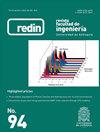层状土(2层)承载能力的数值分析对比评价
IF 0.5
Q3 ENGINEERING, MULTIDISCIPLINARY
Revista Facultad De Ingenieria-universidad De Antioquia
Pub Date : 2021-02-24
DOI:10.19053/01211129.V30.N55.2021.12080
引用次数: 0
摘要
测定层状土承载能力的方法很多,方法和结果各不相同。这些分析上的差异导致工程实践中的不确定性或基础解决方案的过大尺寸。本研究试图确定三种浅基础层状土(2层)承载力分析方法:1)虚基础,2)平均参数法(APM)和3)Terzaghi法,并将其结果与使用广泛应用的软件(Abaqus学术版)的有限元数值模拟结果进行比较。在有限元建模中开发的方法中,变量被参数化(弹性模量、挠曲深度和位移-载荷),并评估了两个行为规律(Elastic和Drucker-Prager)。分析结果表明,利用两层土的弹性特性规律进行数值模拟时,相对于分析方法产生了夸大的结果。另一个重要的结果是,当坚硬的土壤在柔软的土壤上时,1考卡大学(Popayán-Cauca,哥伦比亚)。jairoalejan@unicauca.edu.co。2哥伦比亚考卡大学(Popayán-Cauca);bjmartinez@unicauca.edu.co。ORCID: 0000-0002-22218444 3考卡大学博士(Popayán-Cauca,哥伦比亚)。lucruz@unicauca.edu.co。基于数值分析比较的分层土(2层)承载能力评价[j] .岩土工程学报,Ingeniería (Rev. Fac.)。荷兰国际集团(Ing))。卷30 (55),e12080。1 - 2021。Tunja-Boyaca,哥伦比亚。L-ISSN: 0121-1129, e-ISSN: 2357-5328。DOI: https://doi.org/10.19053/01211129.v30.n55.2021.12080土壤数值方法和解析方法的结果趋于相似。最重要的是,在一层和两层土壤中,对承载能力影响最大的变量是摩擦角、屈服应力,在数值分析中是约束位移(荷载)。此外,还观察到,在数值模拟中,考虑弹塑性模型(如Drucker Prager)可以获得更好的结果。本文章由计算机程序翻译,如有差异,请以英文原文为准。
Evaluation of Load Capacity of Stratified Soils (2 Layers) by Means of Numerical Analytical Comparison
The methods for determining load capacity in stratified soils are numerous and differ in their methods and results. These differences in analysis lead to uncertainty in engineering practices or over-dimensioning of the foundation solution. This study seeks to determine three analytical methods of load capacity in stratified soils (2 layers) for shallow foundations: 1) Imaginary foundation, 2) Average parameter method (APM), and 3) Terzaghi's method to compare their results with those obtained from numerical modeling by means of the finite element method using a widely applied software (Abaqus academic version). Within the methodology developed in the finite element modeling, variables were parameterized (modulus of elasticity, depth of deflection, and displacement-load) and two behavioral laws were evaluated (Elastic and Drucker-Prager). The results that were obtained from the analysis show that when performing numerical modeling using the law of elastic behavior in soils of two layers, exaggerated results are generated with respect to analytical methods. Another important result is that when hard soils are on top of soft 1 Universidad del Cauca (Popayán-Cauca, Colombia). jairoalejan@unicauca.edu.co. ORCID: 0000-0003-13657629 2 Universidad del Cauca (Popayán-Cauca, Colombia). bjmartinez@unicauca.edu.co. ORCID: 0000-0002-22218444 3 Ph. D. Universidad del Cauca (Popayán-Cauca, Colombia). lucruz@unicauca.edu.co. ORCID: 0000-00032438-5526 Evaluation of Load Capacity of Stratified Soils (2 Layers) by Means of Numerical Analytical Comparison Revista Facultad de Ingeniería (Rev. Fac. Ing.) Vol. 30 (55), e12080. January-March 2021. Tunja-Boyacá, Colombia. L-ISSN: 0121-1129, e-ISSN: 2357-5328. DOI: https://doi.org/10.19053/01211129.v30.n55.2021.12080 soils the results of numerical and analytical methods tend to be similar to each other. Most importantly, the variables that have the greatest influence on the load capacity in soils of one and two layers are the angle of friction, yield stress, and in the case of numerical analysis the constraint displacement (load). In addition, it was observed that for numerical modeling better results are obtained when considering an elastoplastic model, such as Drucker Prager.
求助全文
通过发布文献求助,成功后即可免费获取论文全文。
去求助
来源期刊
CiteScore
2.00
自引率
0.00%
发文量
27
审稿时长
2 months
期刊介绍:
Revista Facultad de Ingenieria started in 1984 and is a publication of the School of Engineering at the University of Antioquia.
The main objective of the journal is to promote and stimulate the publishing of national and international scientific research results. The journal publishes original articles, resulting from scientific research, experimental and or simulation studies in engineering sciences, technology, and similar disciplines (Electronics, Telecommunications, Bioengineering, Biotechnology, Electrical, Computer Science, Mechanical, Chemical, Environmental, Materials, Sanitary, Civil and Industrial Engineering).
In exceptional cases, the journal will publish insightful articles related to current important subjects, or revision articles representing a significant contribution to the contextualization of the state of the art in a known relevant topic. Case reports will only be published when those cases are related to studies in which the validity of a methodology is being proven for the first time, or when a significant contribution to the knowledge of an unexplored system can be proven.
All published articles have undergone a peer review process, carried out by experts recognized for their knowledge and contributions to the relevant field.
To adapt the Journal to international standards and to promote the visibility of the published articles; and therefore, to have a greater impact in the global academic community, after November 1st 2013, the journal will accept only manuscripts written in English for reviewing and publication.
Revista Facultad de Ingeniería –redin is entirely financed by University of Antioquia
Since 2015, every article accepted for publication in the journal is assigned a DOI number.

 求助内容:
求助内容: 应助结果提醒方式:
应助结果提醒方式:


